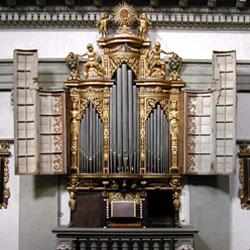
The Accademia d’Organo “Giuseppe Gherardeschi” Pistoia announces their new website: www.accademiagherardeschi.it.
Contents include a calendar of the 2012 Vespers Series performed on organs in Pistoia and surrounding towns, information about the course, “A Week of Full Immersion in the Tuscan Organs,” July 16–22 (see description below), and a list of hard-to-find scores that are available from the academy.
A fee of 50 euros allows one, during the period of one year, to download any or all of the following: two books of toccatas by Claudio Merulo, toccatas nos. 4–7 of Michelangelo Rossi, the organ works of Giuseppe Gherardeschi, his son Luigi, and a Mass by Giuseppe’s nephew Gherardo, as well as works by Bernardo Pasquini, Frescobaldi, and anonymous works by 18th-century Pistoiese composers. All the music is edited by Umberto Pineschi.
The summer course includes performance and discussion of Italian organ literature, Bach’s concertos, music for two organs, and a Mass in the Tridentine rite, with Gregorian chant alternated with Gherardeschi’s Messa in Elafà.
Instruments include four historic organs in Pistoia (S. Ignazio, S. Filippo, Cathedral and Carmine), and a new organ built in north German style, plus two recent two-manual organs, a harpsichord and a clavichord. Instructors include Umberto Pineschi, Andrea Vannucchi, and Masakata Kanazawa.


